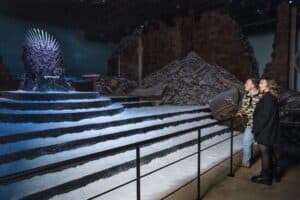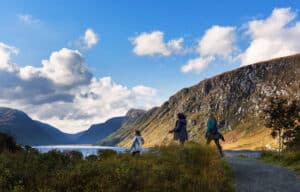Pride, honor, tradition – the Scottish clan system has them all. The clans’ colorful history, rich customs and vibrant heritage left a deep impact on the overall culture of Scotland. Things weren’t always easy – in fact, challenges were more common than not. The Scottish clans’ way of life consisted of living off they land, and border disputes were the main cause of inter-clan unrest. Clan chiefs were highly powerful and used their roles to lead battles and make important decisions for their members. They acted as part-kings, part-protectorates and part-judges.
This system saw a loss in power after the bloody Battle of Culloden when King George II’s troops crushed the Jacobite rebellion. Despite this, not even the Battle of Culloden could diminish their prominence.
There are over 500 Scottish clan and family associations registered around the world. Many of these clans can be traced back to specific areas of Scotland. There’s nothing quite like setting foot in your clan’s homeland and seeing it for yourself. Have a wee bit of Scottish in you? Perhaps you’ll find your clan listed below.
 Campbell
Campbell- Inveraray Castle – the ancestral seat of the Dukes of Argyll, Chiefs of Clan Campbell. You’ll find great genealogical illustrations on display in the Clan Room.
- Cawdor Castle, which came into the Campbells’ ownership in the 16th century. According to legend, it’s built around a thorn tree dating back to 1372.
- The beautifully sited Castle Campbell & Gardens located near Ochil Hills.

Points of interest to the Douglas Clan are:
- Drumlanrig Castle, which hosts much of the clan’s memorabilia on display.
- Castle Douglas – a market town dating to the 18th century. It’s located on an island and its great fortress Threave Castle can be reached via ferry.
- The picturesque Tantallon Castle built by William 1st Earl of Douglas.
 Fraser
Fraser
The origin of the name ‘Fraser’ is French. It’s said a frenchman gave strawberries to the King of France. The strawberries were so good, the king granted him a coat of arms and had him change his name to Fraise (French for ‘strawberry’). Clan Fraser has two distinct branches, one in the Lowlands and one in the Highlands. Many members have distinguished themselves (and not just in the famous Outlander series).
Some famous Fraser spots are:
- Scotland’s ancient capital of Stirling which is full of history and culture.
- Aberdeen – a location connected to many famous Frasers.
- Culloden Battlefield – a prominent spot for all clans playing a part in the Jacobite Rising. Outlander fans and Clan members alike will appreciate the Fraser monument.
MacDonald 
Known as the ‘Lords of the Isles’, this clan’s ancient chiefs once controlled lands and waterways in the west highlands and the Hebrides. For centuries, the MacDonald Clan made up the largest amount of landowners and were the most powerful lords in the British Isles after the Kings of England and Scotland. While their remaining land has decreased, the MacDonald Clan is still in possession of the tiny island of Cara.
If you’re a member of the MacDonald Clan, you may wish to visit:
- Armadale Castle on the Isle of Skye. This romantic Clan Donald castle offers the chance to explore 1500 years of Clan history in its award-winning Museum of the Isles.
- The somber, breathtaking Glencoe. This is a very sad place in particular for Clan Donald. It was here in 1692 that 38 clan members were betrayed and killed by government troops they were hosting.
- Finlaggan Castle on Eilean Mòr in Loch Finlaggan. Finlaggan was the seat of the Lord of the Isles and of Clan Donald. Not much of the castle remains to this day, but the Finlaggan Trust maintains the site with a refurbished cottage converted into a museum. You’ll find the likes of armor, sheep wool and an ancient cross related to the lords.
Stuart/Stewart
The Clan Stuart/Stewart has royal roots and once ruled Scotland from 1371 to 1603. Some famous Stuarts/Stewarts include Mary, Queen of Scots, Bonnie Prince Charlie and Jackie Stewart (‘the Flying Scot’).
Some noteworthy Stuart/Stewart locations are:
- Inchmahome Priory on an island off of Lake Menteith. This was briefly the home of Mary, Queen of Scots. The priory showcases the grave slabs and effigies of Stuart/Stewart earls and knights.
- Mount Stuart on the Isle of Bute. Its design was influenced by astrology, astronomy, botany and science. You’ll find this red sandstone Victorian Gothic masterpiece to be one of Scotland’s most stunning stately homes.
- Traquair House in the Scottish Borders. This is the only continuously inhabited house in the area. Its famous Bear Gates were shut in 1745 and are not to be opened again until a Stuart monarch sits on the throne.
Wallace 
This Clan is recognized by many thanks to the legendary patriot William Wallace who fought for Scotland’s independence. The name is of French origin from the word ‘waleis’ meaning ‘welshman’, as the earliest Wallace known in Scottish history was Richard Walensis who was from the Welsh border area.
If you’re of the Wallace Clan, you’ll want to visit the following places:
- the Wallace Monument, located near Stirling Bridge. This is where William Wallace led the Scots to victory. You can step inside and discover interesting exhibits like Wallace’s sword, which is five feet and four inches long and weighs more than 16 pounds.
- Roslin Glen Country Park. The Battle of Rosslyn took place here in 1303 and the Scots defeated the English with William Wallace’s help. Be sure to check out Wallace’s Cave within the park.
- Lanark Museum, which shares a look at William Wallace’s connections to the town of Lanark. According to Legend, he married his wife Marion Braidfute there in St Kentigern’s Church.
 Mackenzie
Mackenzie
This Clan originates from their lands of Kintail and Ross-shire, with Eileen Donan being their original home. It’s said Eileen Donan was the Clan’s reward for helping to defeat the invading Norsemen at the Battle of Largs. The Mackenzie Clan famously feuded with the neighboring Clans of Munro and MacDonald. This surname is MacCoinneach in Scottish Gaelic and means ‘son of the fair, bright one.’
Apart from Eileen Donan, other Mackenzie destinations are:
- Castle Leod – one of the most beautiful castles in the Highlands. This castle inspired ‘Outlander’ author Diana Gabaldon to create her fictional Castle Leoch.
- the Highlanders Museum in Fort George. You’ll discover the story of three Mackenzie regiments raised for the British Army.
- Glen Ord Distillery – for a sip of the ‘water of life’. This distillery was once owned by a Mackenzie.





